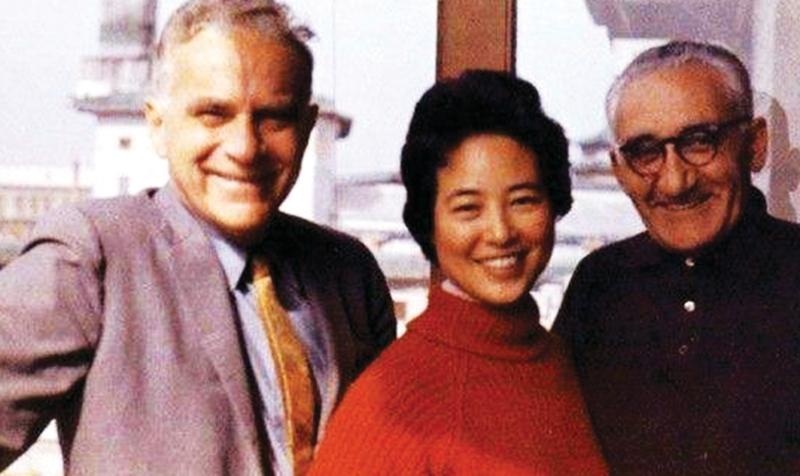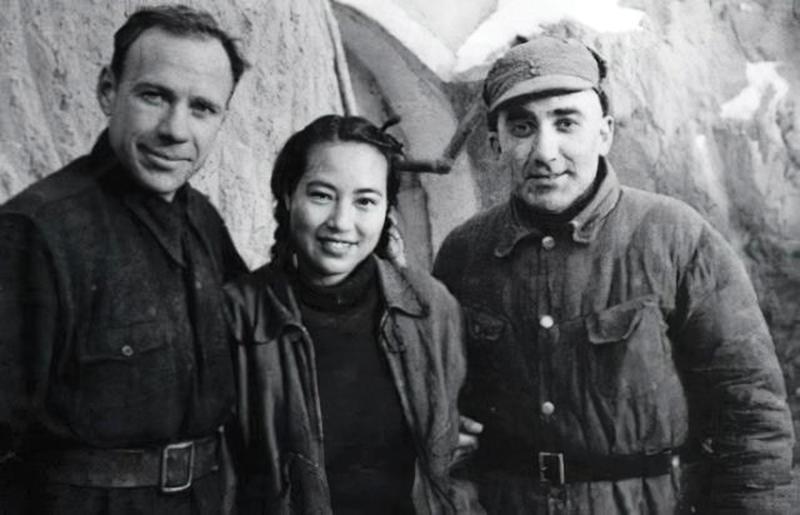 American journalist Edgar Snow (left), Zhou Sufei and Hatem meet each other again in Beijing in 1964. (PHOTO PROVIDED TO CHINA DAILY)
American journalist Edgar Snow (left), Zhou Sufei and Hatem meet each other again in Beijing in 1964. (PHOTO PROVIDED TO CHINA DAILY)
Shortly before the founding of the People’s Republic of China, a stoutly-built foreigner came to revolutionary leader Zhou Enlai’s office. Speaking in fluent Mandarin with a Shaanxi accent, the visitor said, “Vice-Chairman Zhou, ten years ago, you had agreed to a request from me!”
Laughing out loud, Zhou, who was then vice-chairman of the Central Military Commission of the Communist Party of China, responded: “Right, right, dear Doctor Ma Haide, I’ll keep my promise.”
The reference was to an assurance that Zhou, who later became premier, gave many years ago to the visitor, whose actual name was George Hatem, about providing Chinese citizenship.
Hatem, an American national who had been living in China, had asked Zhou about becoming a Chinese citizen as early as 1937. Zhou guaranteed him that he would grant Hatem — who had taken on the Chinese name Ma Haide — the citizenship soon after the New China is founded.
On Oct 1, 1949, Hatem was invited to the Tian’anmen gate tower for the founding ceremony of the People’s Republic of China. In 1950, he became the first foreigner granted Chinese citizenship, having his certificate formally signed by Premier Zhou, and was also made a public health official by the CPC.
The American-born doctor had then realized the last of his three big wishes. The other two, which came to fruition earlier, had been the world winning the battle against Fascist forces; and him marrying a Chinese woman. With citizenship, Hatem felt he was “Chinese” in a complete sense.
In fact, Hatem was also the first Westerner exceptionally approved to become a CPC member. “I felt extremely delighted to be able to participate in this great cause of liberation, to get truly involved, rather than stay as an outsider,” Hatem once said.
Hatem was born into a family of Lebanese origin in Buffalo in the United States in 1910. He was inspired to study medicine after a doctor saved his whole family by giving them free treatment for influenza. In 1933, he received a doctoral degree in medicine from the University of Geneva, in Switzerland.
In the same year, he came to Shanghai with two other doctors to study tropical epidemic diseases in Oriental countries. They opened a clinic together.
Influenced by his friends, Hatem began to read Marxist works and study China’s revolution. That was how he came to know the other world in China — the CPC revolutionary base. He even used his own clinic as a liaison site for the underground work of CPC in Shanghai.
In June 1936, upon the recommendation of his friend Soong Ching Ling, Hatem joined American journalist Edgar Snow on an important “secret mission”. Snow first set off from Beijing and he was later joined by his compatriot Hatem in Zhengzhou, the capital of Henan province.
Life-changing journey
Together they went on a trip to Bao’an, Shaanxi, then temporary headquarters of the Chinese Red Army. When Snow arrived in Yan’an, an iconic CPC revolutionary base, where he met the welcoming Party official Zhou for the first time on July 9, Hatem captured an image, albeit shaky, of the historic moment with an old-fashioned camera.
Witnessing the extremely simple but lofty life that Zhou and other Party leaders were living, and greatly inspired by their faith in the CPC, Hatem decided to stay with the army. In the ensuing months, he joined different Red Army troops at their operations and witnessed the extraordinary people’s army with his own eyes.
The three months in northern Shaanxi let Hatem see the real CPC. He was impressed by the indomitable Red Army soldiers and their solidarity amid tremendous hardships.
Once, during a march, the troops were suffering a severe shortage of necessities and every one was hungry and exhausted. Seeing Hatem too tired to go further, an old soldier fumbled in his pocket and handed Hatem a small piece of rock candy.
Braving all odds, the army and the people were united as one. Such optimism was rarely seen in other places in China at that time.
It inspired Hatem to stay in China for the rest of his life, as he believed that only the Chinese people can change the future of their country.
 George Hatem (right) pictured in Yan’an. (PHOTO PROVIDED TO CHINA DAILY)
George Hatem (right) pictured in Yan’an. (PHOTO PROVIDED TO CHINA DAILY)
In October 1936, Snow, after doing interviews in Yan’an, asked Hatem about leaving with him. Hatem, however, made a big decision: He would stay in northern Shaanxi. “I’m a doctor, and the Red Army needs me,” Hatem said firmly.
For the next ten years, Hatem stayed in Yan’an. He learned to speak both Mandarin and the local Shaanxi dialects, and gave himself a Chinese name “Ma Haide”.
He served as the family doctor for revolutionary leader Mao Zedong, and helped check the health conditions of many other party officials. Together with other doctors, he helped treat Zhou when he fell off a horse and hurt his arm. Between 1944 and 1947, Hatem received more than 40,000 patients in the base.
After the three main forces of the Chinese Red Army converged in October 1936, Hatem, who had been appointed public health adviser to the Central Military Commission of the CPC, stayed in the troops. He also assisted in establishing modern hospitals in the Revolutionary Base Areas in Shaanxi, Gansu and Ningxia.
On the battlefield, Hatem saw soldiers who braved all dangers on the front line. He saw high-ranking Red Army officers such as Zhu De and He Long give their own horses to the injured. Young soldiers laid down their lives for new China.
Deeply moved, Hatem applied to join the CPC. In February 1937, he officially became a CPC member.
Hatem also found his love in the CPC revolutionary base. In 1939, he met Chinese actress Zhou Sufei, who had just left Shanghai for Yan’an. They got married in Yan’an a year later. In 1943, they gave birth to a son, Zhou Youma.
In June 1944, Harrison Forman, Israel Epstein, Gunther Stein and other foreign journalists came to Yan’an to conduct interviews. They talked with Hatem, among others.
“One of the things I like most about this place,” said Hatem, “is that there is absolutely no professional jealousy here. This is due in large measure to the fact that there is no financial incentive, no rivalry for special honors or favors. All of us work together like members of a big family, and satisfactions and disappointments are mutually shared.”
Hatem said he learned a lot in Yan’an, “They taught me a very great deal (that) I probably couldn’t have learned any other way. And I had some pretty swell people to learn from, you must admit.”
In 1950, Hatem was appointed medical consultant for the Ministry of Health of the PRC.
He helped to establish the Central Dermatovenerology Institute, and devoted himself to the prevention and treatment of and research on venereal diseases and leprosy.
After succeeding in the fight to root out venereal diseases in China in 1964, Hatem devoted himself again to leading the campaign of leprosy eradication. However, he found that for leprosy, a disease prevalent in some parts of China for thousands of years, changing or reversing people’s deep-rooted prejudice against the patients was more important than simply treating it.
Hands for healing
In some backward areas in the country, leprosy patients spent their whole life in isolation, ignorance and discrimination, and they suffered both physical and mental pain.
As the first in China to promote the scientific notion that “leprosy is preventable, curable, and not terrible”, Hatem spared no effort in spreading the message. The leprosy virus can be controlled within three days after medication and then eliminated, so it is no longer contagious, he said.
In a specialized hospital for leprosy in Hebei province in 1982, when Hatem reached out his hand to a patient, the old man was taken aback, hesitating to respond.
As Hatem took the initiative to take his hand, the man instantly burst into tears, saying: “Since I got infected with this disease, for over 25 years, no one dared to shake hands with me! Doctor Ma is the first!”
Hatem shook hands and chatted with leprosy patients, and even touched the ulcerated part of patients’ skin with his hands directly. His moves helped dispel the patients’ uneasiness and lack of confidence.
To root out the disease, Hatem kept making trips to even the most remote mountainous areas, even as he had suffered cancer and had undergone many operations since 1976.
To get the medicine and funds needed to prevent and treat leprosy, Hatem also visited more than a dozen countries to get assistance.
Thanks to decades of dedicated efforts by Hatem and his colleagues, the results of China’s leprosy prevention and control were recognized by the world. The number of patients in China dropped to around 6,000 in 2007 from over 520,000 in 1949. The goal that Hatem had set to eradicate leprosy in China by 2000 was realized.
The doctor passed away in 1988 due to pancreatic cancer and other diseases. Steven B. Sample, president of the university at Buffalo, was quoted in an article published in the New York Times after his death, “Few people in history can equal the medical successes of Dr. George Hatem.’’ Over the past half century, Sample said, Hatem saved “many millions of Chinese”.
Part of Hatem’s ashes was sent to be put in a river in Yan’an, and part of it back to Buffalo, and the rest stayed in Beijing, as per his wishes. Hatem’s tomb is among those of famous artists, poets, musicians, soldiers and statesmen at Babaoshan Revolutionary Cemetery.
His wife Zhou Sufei, 101, has no fears about her husband’s legacy being remembered. “When I go to my husband’s tomb, there are always flowers beside it,” she said.
Looking back, Hatem once said that the past fifty years of life taught him a truth: One must have strong convictions to be useful for the society, and that life is about fighting against difficulties and scaling new heights.
“If I were to start my life again, I will still pick up this same path. There is no doubt about it,” Hatem said.


